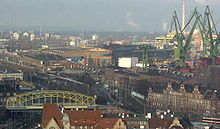Shipyard Gdansk
The Danzig shipyard AG ( Stocznia Gdańsk Spółka Akcyjna in Polish , until 2006: Stocznia Gdańska ) is the successor to the Lenin shipyard that existed in Danzig until 1990 .
The Gdańsk Shipyard is one of the largest shipyards in Poland . It is located to the west of the Vistula estuary Martwa Wisła on the island of Ostrów .
History of the shipyard until 1989
Today's shipyard goes back to the Kaiserliche Werft founded in 1844 (from 1919 Danziger Werft and railway workshops ) and the branch of the Elbinger Schichau shipyard founded in 1890 . In 1945 the original German owners of the company were expropriated by the Polish state without compensation due to their German nationality. The first ship built in Poland after the Second World War, the Sołdek , was launched at this shipyard in 1950 . On April 15, 1967, the shipyard in Stocznia Gdańska im. Renamed Lenina ("Danzig Shipyard, named after Lenin "). In the following years, this name was mostly shortened to Lenin-Werft in the German media .
Since the 1960s, the workers at the shipyard have been regarded as "rebellious" and stubborn. In December 1970 (illegal) strikes and work stoppages were carried out, which were bloodily suppressed by the state. The electrician Lech Wałęsa had been a member of the workers' strike committees since the mid-1970s. Another leading figure was crane operator Anna Walentynowicz . Internationally known the shipyard, as in was strike summer of 1980 after the signing of the August Agreement in the Occupational Safety Hall shipyard trade union Solidarity was founded. The shipyard is considered to be the nucleus of the democratic movement in Poland. The union leader Lech Wałęsa was elected President of Poland on December 9, 1990.
privatization
In the course of the privatization of the former socialist state-owned companies at the beginning of the 1990s, the shipyard was converted into a public limited company. As a result of the privatization, the shipyard's workforce was reduced from 15,760 employees (1978) to less than 3,000 (in 2007).
After assuming government responsibility in 2006, the Law and Justice Party (PiS) commissioned the ethnologist Andrzej Jaworski (who also belonged to this party) to manage the shipyard, even though he had no experience in shipbuilding. Under pressure from the trade unions, Jaworski split the Gdansk shipyard from Gdynia and in December 2006 sold 5% of the shares in the Gdansk shipyard to ISD Polska , a subsidiary of the Ukrainian steel and steel company Industrialnyj Soyuz Donabass (ISD) from the Donbas . In November 2007, ISD Polska took over newly issued shares for 300 million zloty , increasing its stake to 83%. When ISD also wanted to acquire the Gdynia shipyard, the European Commission demanded that the shipyards repay the state aid, reduce their production or be privatized by the end of June 2008. The Polish state subsidized its shipyards with a total of 5 billion zlotys.
The shipyard has also been manufacturing components for wind turbines since 2010 . In 2014 the shipyard employed a good 700 people.
seal
Because of the importance of the shipyards for development in Europe, they were awarded the European Heritage Label .
Web links
- Shipyard website (Polish, English)
Footnotes
- ↑ Gazeta Wyborcza, June 26, 2008, p. 24.
- ^ Klaus Brill : Monument for Solidarity. The European Solidarność Center is being built on the site of the legendary Gdansk shipyard . In: Süddeutsche Zeitung, August 12, 2014, p. 8.
Coordinates: 54 ° 22 ′ 8 ″ N , 18 ° 39 ′ 10 ″ E


